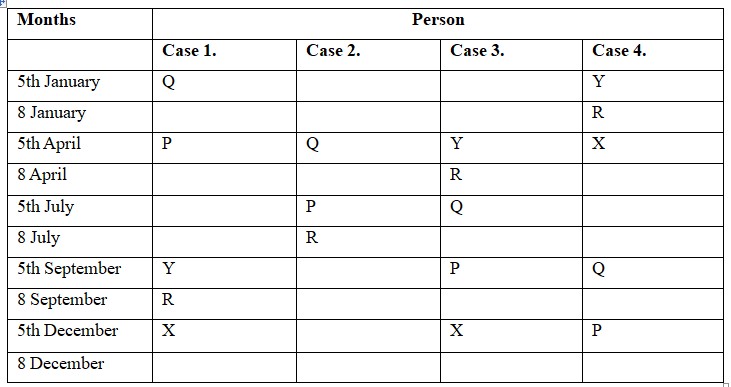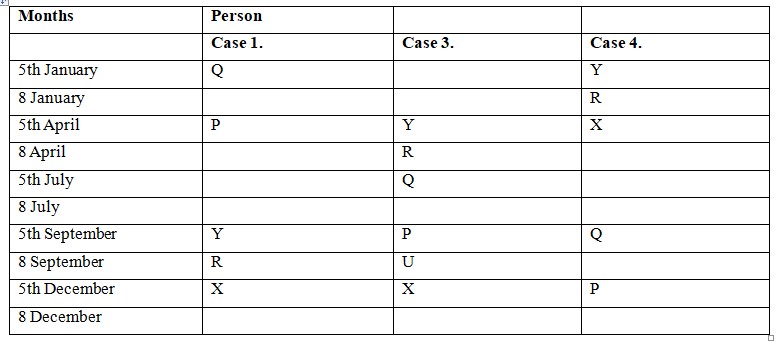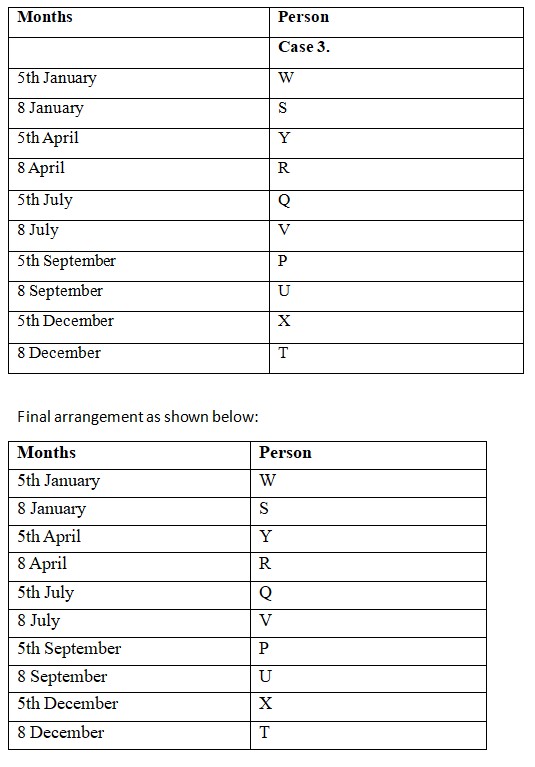Question
How many persons attending the seminar between S and
V? Study the following information carefully and answer the below questions. Ten persons namely –P, Q, R, S, T, U, V, W, X, and Y attend a seminar event in five different months viz.- January, April, July, September, December. Seminar in each month was scheduled on the 5thrd and 8th of the month. All the information is not necessary in the same order. The number of persons is attending a seminar after P is the same as the number of persons is attending the seminar before R. P attends seminar two months after Q, who attends the seminar on an odd date. R and Y attend the seminar in the same month. The number of persons is attending the seminar between Y and Q is the same as the number of persons is attending the seminar between P and X. The number of persons attending the seminar between U and R is one less than the number of persons is attending the seminar between W and V. U attends seminar three months before X, who attends seminar in one of the months has 31 days. V attends seminar on the 8th of the month but not in January. W and S attend seminars in the same month. At least two persons attend the seminar between T and P.Solution
The number of persons is attending a seminar after P is the same as the number of persons is attending the seminar before R. P attends seminar two months after Q, who attends the seminar on an odd date. R and Y attend the seminar in the same month. We will have four cases: If Q attends seminar on 5th January, then P will attend on 5th April. R will attend on 8 September and Y will attend on 5th September. If Q attends seminar on 5th April, then P will attend on 5th July. R will attend on 8 July but we do not have dates for Y. If Q attends seminar on 5th July, then P will attend on 5th September. R will attend on 8 April and Y will attend on 5th April. If Q attends seminar on 5th September, then P will attend on 5th December. R will attend on 8 January and Y will attend on 5th January.  The number of persons is attending the seminar between Y and Q is the same as the number of persons is attending the seminar between P and X. In case 1, there are five person between Q and Y. So, X attends seminar on 5th December. In case 3, there is one person between Q and Y. So, X attends seminar on 5th December. In case 4, there are five person between Q and Y. So, X attends seminar on 5th April. U attends seminar three months before X, who attends seminar in one of the months has 31 days. Case 1 and 4 will get discarded as we know that X attends the seminar in December and U should have attended in September. In case 3, U attends seminar on 8 September
The number of persons is attending the seminar between Y and Q is the same as the number of persons is attending the seminar between P and X. In case 1, there are five person between Q and Y. So, X attends seminar on 5th December. In case 3, there is one person between Q and Y. So, X attends seminar on 5th December. In case 4, there are five person between Q and Y. So, X attends seminar on 5th April. U attends seminar three months before X, who attends seminar in one of the months has 31 days. Case 1 and 4 will get discarded as we know that X attends the seminar in December and U should have attended in September. In case 3, U attends seminar on 8 September  At least two persons attend the seminar between T and P. So, T attends seminar on 8 December. V attends seminar on the 8th of the month but not in January. Now it is clear that V attends the seminar on 8 July. The number of persons attending the seminar between U and R is one less than the number of persons is attending the seminar between W and V . W and S attend seminars in the same month. We know that three person are there between U and R. It means that there would have been four person between V and W. So, W and S attend seminar on 5th January and 8 January respectively.
At least two persons attend the seminar between T and P. So, T attends seminar on 8 December. V attends seminar on the 8th of the month but not in January. Now it is clear that V attends the seminar on 8 July. The number of persons attending the seminar between U and R is one less than the number of persons is attending the seminar between W and V . W and S attend seminars in the same month. We know that three person are there between U and R. It means that there would have been four person between V and W. So, W and S attend seminar on 5th January and 8 January respectively.  Practice Next
Practice Next
In a certain code language,
A + B means ‘A is the brother of B’.
A − B means ‘A is the father of B’.
A × B means ‘A is...
18 Kishor starts from Point A and drives 36 km towards east. He then takes a right turn, drives 34 km, turns right and drives 39 km. He then takes a rig...
In each of the number-pairs, the second number is obtained by performing a certain mathematical operation on the first number. Three of the following pa...
Shilps and Radhika started walking from two different points, 'A' and 'B', respectively. Shilpa walks 4 km North, turns to the East and walks 6 km, agai...
What will come in the place of the question mark (?) in the following equation, if '+' and '–' are interchanged and '×' and '÷' are interchanged?<...
i) sitting on the third position on the right side of the F, A is sitting in the second position on the left side.
ii) C is either sitting in ...
Pointing to a lady Jayant says, "She is the sister of Prikshit, who is the brother of Dushyant and the brother of Abha."
Abha is the sister-in-la...
Find the missing figure from the given series.
3, 13, 1113, 3113, ______
In a certain code language, 'FRONT' is coded as '21593' and 'OFTEN' is coded as "52739'. What is the code for 'E' in the given code language?
Three of the following numbers are alike in a certain way and one is different. Pick the odd one out. (NOTE : Operations should be performed on the whol...
Relevant for Exams:



